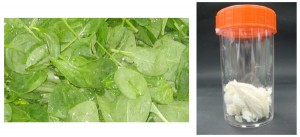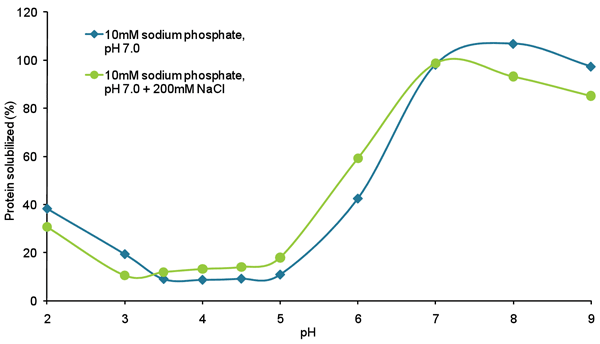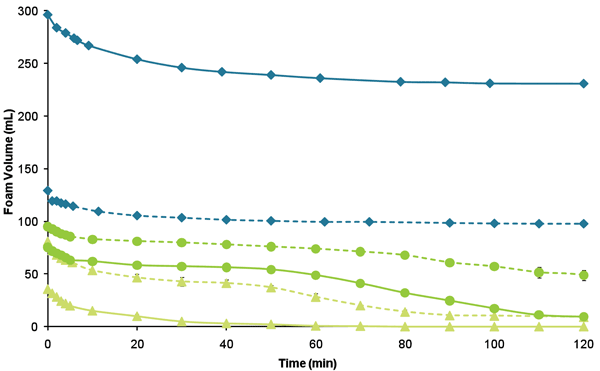From waste product to food ingredient: The extraction of abundant plant protein RuBisCo
- Like
- Digg
- Del
- Tumblr
- VKontakte
- Buffer
- Love This
- Odnoklassniki
- Meneame
- Blogger
- Amazon
- Yahoo Mail
- Gmail
- AOL
- Newsvine
- HackerNews
- Evernote
- MySpace
- Mail.ru
- Viadeo
- Line
- Comments
- Yummly
- SMS
- Viber
- Telegram
- Subscribe
- Skype
- Facebook Messenger
- Kakao
- LiveJournal
- Yammer
- Edgar
- Fintel
- Mix
- Instapaper
- Copy Link
Posted: 13 May 2011 | Fred van de Velde, Group Leader Ingredient Technology, and Arno Alting, Project Manager Applied Protein Technology, and Laurice Pouvreau, Project Manager Vegetable – Derived Ingredients, NIZO Protein Centre, NIZO food research | 2 comments
Due to an ever-growing population, proteins extracted from existing agricultural side-streams are of high interest for food processors. RuBisCO, being the most abundant protein in the world, is a very good candidate for food applications. However, up to now, the greenish colour associated with RuBisCO preparations made consumer acceptance very difficult. NIZO food research has developed a simple and up-scalable extraction process for RuBisCO yielding to a colourless protein isolate with a high percentage of undenatured protein (Figure 1 opposite). Moreover, the protein isolate displays promising techno-functional properties, such as a high foam volume and stability and a heat-induced gelation at low protein content (two per cent w/w).
Due to an ever-growing population, proteins extracted from existing agricultural side-streams are of high interest for food processors. RuBisCO, being the most abundant protein in the world, is a very good candidate for food applications. However, up to now, the greenish colour associated with RuBisCO preparations made consumer acceptance very difficult. NIZO food research has developed a simple and up-scalable extraction process for RuBisCO yielding to a colourless protein isolate with a high percentage of undenatured protein (Figure 1 opposite). Moreover, the protein isolate displays promising techno-functional properties, such as a high foam volume and stability and a heat-induced gelation at low protein content (two per cent w/w).
Due to an ever-growing population, proteins extracted from existing agricultural side-streams are of high interest for food processors. RuBisCO, being the most abundant protein in the world, is a very good candidate for food applications. However, up to now, the greenish colour associated with RuBisCO preparations made consumer acceptance very difficult. NIZO food research has developed a simple and up-scalable extraction process for RuBisCO yielding to a colourless protein isolate with a high percentage of undenatured protein (Figure 1). Moreover, the protein isolate displays promising techno-functional properties, such as a high foam volume and stability and a heat-induced gelation at low protein content (two per cent w/w).


Figure 1 From spinach to colourless RuBisCO isolate
With an expected growth of the world population to above nine billion (2050) and a subsequent increasing demand for high nutritional foods, there will be an enormous pressure on the future food production system to fulfil this demand. Plant proteins are known to be more sustainable than animal proteins and more cost effective1,2. (Partly) replacing animal protein in existing products with (new) plant protein ingredients or developing new plant protein-based products may contribute to an efficient use of available proteins. A further step to reduce the environmental impact of food production can be taken by extracting protein from food sidestreams and thereby reducing wastage in the food chain. In answer to the above, scientists of the NIZO Protein Centre developed a process to extract RuBisCO, the most abundant plant protein. They managed it in a food-grade manner, while maintaining the functional properties of this new food ingredient.
RuBisCO
Ribulose-1,5-bisphosphate carboxylase oxygenase, most commonly known by the shorter name RuBisCO, is an enzyme that catalyses the first major step of carbon fixation, a process by which atmospheric carbon dioxide and water is converted to energy-rich molecules such as glucose, using sunlight3. In green parts of plants, the protein RuBisCO can make up to 50 per cent of the total amount of the protein fraction. Thereby, RuBisCO is the key photosynthetic enzyme in green leaves of plants and is considered the most abundant protein present on earth4. Densely packed RuBisCO is located inside the mobile phase of the chloroplast stroma at concentrations of approximately 300 mg/mL4. However, the concentration of RuBisCO obtained from green leaves depends upon many factors, such as the age of the plant at the time of harvest, the species, the growing conditions (such as light intensity and nitrogen availability) and of course the efficiency of the method used to extract the protein5. Besides its abundant presences throughout the world, RuBisCO is of potential interest for human consumption due to its high nutritional value. RuBisCO contains high amounts of essential amino acids, which makes RuBisCO rather unique among vegetable proteins. The amino acid composition of RuBisCO was compared to the level recommended by the FAO/WHO reference pattern for human nutrition and RuBisCO showed a chemical score of 98 (Table 1)5.
Table 1. Comparison of the essential amino acid composition of RuBisCO and other food proteins with the FAO/WHO reference pattern for human nutritiona.
| Amino acid | FAO/WHO | Whole egg | Casein | Soybean meal | RuBisCO | Chemical scoreb |
| Lysine | 5.5 | 6.4 | 8.0 | 6.9 | 6.5 | >100 |
| Tryptophan | 1.0 | 1.2 | 1.3 | 1.3 | 2.7 | >100 |
| Threonine | 4.0 | 5.0 | 4.3 | 4.3 | 5.3 | >100 |
| 1/2 Cystine and methionine | 3.5 | 5.5 | 3.5 | 2.4 | 3.4 | 98 |
| Valine | 5.0 | 7.4 | 7.4 | 5.4 | 6.7 | >100 |
| Isoleucine | 4.0 | 6.6 | 6.6 | 5.1 | 4.9 | >100 |
| Leucine | 7.0 | 8.8 | 10.0 | 7.7 | 9.4 | >100 |
| Triosine and phenylalanine | 6.0 | 10.1 | 11.2 | 8.9 | 12.8 | >100 |
Plant waste materials
Up to 50 per cent of the total protein in green leaves consists of RuBisCO. The amount of protein in green leaves varies between 1.2 per cent and 8.2 per cent on a wet weight basis6 depending on the characteristics of the plant and its growing conditions. Thus the maximum concentration of RuBisCO in leaf / plant juice varies between 0.6 per cent and 4.1 per cent, of which the latter value is comparable to the protein content of cow milk (3.5 per cent). RuBisCO is present in many edible plants, such as spinach and alfalfa as well as in many edible side-streams such as sugar beet, corn and carrot leaves and pea pods.
Extraction of RuBisCO
Food processors only change to new protein ingredients in their products when this does not negatively affect product liking (taste, texture) and gives benefits in attributes, terms like costs, image, health, taste and texture. In practice, new plant protein ingredients have difficulties in establishing a position on the market because they often score less on one or more of these relevant attributes compared to animal-based proteins.Earlier research5 has shown that RuBisCO combines good nutritional properties with a good techno-functional performance. Until now, the main challenge was to develop a food-grade extraction process maintaining these properties and providing a colourless powder which can be applied in food at large scale. RuBisCO is easily purified from leaf extracts in the laboratory but, as yet, no simple, economical method for isolating large (kilogram) quantities of the plant protein is available. Highly purified RuBisCO is a tasteless, odourless white powder with a nutritional value reported to be equal to or superior to that of other food proteins. RuBisCO also possesses some desirable functional properties which might enable food processors to successfully incorporate the protein into a number of different food products (desserts, composite meat products, ice cream, beverages). Further developments are to come to test RuBisCO into food systems such as desserts / yogurt for texturing and flavouring improvements.
Earlier methods for isolating RuBisCO from plant material suffer from a number of drawbacks. First of all, some of these methods yield RuBisCO preparations that have a greenish colour due to the presence of high levels of chlorophyll7-10. RuBisCO preparations that have such a greenish colour are generally unsuited for application in foods and beverages and are not acceptable from the consumer side. Other drawbacks of the prior art methods reside in the fact that they rely on precipitation of RuBisCO using organic solvent (polyethylene glycol) and/or acidification. A disadvantage of precipitation is that the precipitated protein usually needs to be redissolved for further processing and that it may cause denaturation / aggregation of the protein, thereby lowering its solubility.
The NIZO isolation process
In the NIZO Protein Centre, a method has been developed for the extraction of RuBisCO from green plants that results in a protein ingredient that has maintained its techno-functional properties, such as solubility and gelling behaviour. NIZO food research has filed a patent application for the extraction process and the product obtained. Laboratory experiments showed that the green colour and solubility issues could be solved. Furthermore, the process was scaled to semi-industrial scale in the foodgrade Processing Centre of NIZO food research. On this scale, sufficient amounts of material could be isolated / produced to test the functional properties of the isolated RuBisCO.
The present process, when performed using spinach as a starting material, yield a dechlorophyllised RuBisCO isolate, containing over 90 wt. per cent of undenatured RuBisCO and containing less than 0.1 per cent of chlorophyll by weight of RuBisCO. The process was also successfully performed with sugar beet and carrot leaves.
Techno-functional properties Solubility
The solubility of the RuBisCO as a function of pH at high and low ionic strength is shown in Figure 2. RuBisCO solubility is minimal between pH 3.5 and 5.0 at both ionic strength. Independent of the ionic strength, the solubility increases towards neutral and alkali pHs (from pH 6.0 to 9.0) and towards acidic pHs (pH below 3). The increase in ionic strength did not have a significant effect on solubility in the tested conditions. The solubility profile of RuBisCO, extracted from spinach, is similar to the one described in literature for RuBisCO extracted from alfalfa11.


Figure 2 Solubility of RuBisCO isolate from spinach as a function of pH at high and low ionic strength
Foaming properties
Foam prepared with RuBisCO isolate had a higher foam volume than the foam prepared with other commercial proteins such as soy and whey protein isolates (Figure 3). The bubbles were significantly smaller when using RuBisCO than those obtained using soy or whey proteins. Contrary to soy and whey proteins, the foam volume using RuBisCO was significantly larger at pH 7.0 than at pH 4.5. In addition, foam prepared with RuBisCO was found to be the most stable foam over a period of two hours at both pH values with no apparent coalescence within the first two hours. RuBisCO foam could be used as an alternative for dairy-based foams for applications such as coffee, ice cream and desserts.


Figure 3 Foam volume over two hours of RuBisCO (♦), soy (▲) and whey protein (●) isolates at two different pHs (4.5: dotted line and 7: solid line)
Gelling properties
RuBisCO proteins gelled at a lower concentration compared to soy and whey proteins (Figure 4). These results are in agreement with results in literature regarding the gelling behaviour12,13 in which RuBisCO was extracted at lab-scale. The results show that, at pH 7.0, the heat gelation of RuBisCO starts at around two per cent w/w protein, while for whey proteins it only starts around 10 per cent w/w proteins and for soy at only concentration higher than 12 per cent w/w proteins. The high gelling potential of RuBisCO enables possible application in desserts, targeted for vegetarian consumers and with the label low-allergenicity.


Figure 4 Gel strength as a function of protein concentration at pH 7.0 for RuBisCO (♦), soy (▲) and whey protein isolate (●).
Next steps
Next steps for applying RuBisCO in food products are: 1) The scaling-up of the extraction process to several kilograms of RuBisCO isolate with an industrial partner and for specific agricultural side-stream(s); and 2) Texture and flavour properties within various food systems, such as dessert, yogurt, ice-cream, etc., using RuBisCO protein as the solely protein source or to partly replace dairy proteins.
References
1. Aiking, H., J. de Boer and J. Vereijken (2006) Sustainable protein production and consumption: Pigs or peas? Springer, Dordrecht, The Netherlands
2. Steinfield, H., P. Gerber, T. Wassenaar, V. Castel, M. Rosales and C. de Haan (2006) Lifestock’s long shadow Environmental issues and options. FAO rapport, Rome, ISBN 92-5-105571-7
3. Weissbach, A.; Horecker, B. L.; Hurwitz, J. (1956) The enzymatic formation of phosphoglyceric acid from ribulose diphosphate and carbon dioxide. Journal of Biological chemistry, 218, 795
4. Ellis, J.R. (1979) The most abundant protein in the world. Trends in biochemical Science, 4, 241-244
5. Barbeau, W. E. and Kinsella, J.E. (1988) Ribulose biphosphate carboxylase/oxygenase (RuBisCO) from green leaves – Potential as a food protein. Food Reviews International, 4, 93-127
6. Martin, F.W. and Ruberte, R.M. (1975) Edible leaves of the tropics. Agency for international development, Washington, DC
7. Bickoff, E.M., D. de Fremery, R.H. Edwards, B.E. Knuckles, G.O. Kholer and R.E. Miller (1976) Preparation of soluble edible protein from leafy green crops. US patent application 3,959,246 (published 1976-05-25)
8. Bickoff, E.M., D. de Fremery, R.H. Edwards, B.E. Knuckles, G.O. Kholer and R.E. Miller (1977) Preparation of soluble edible protein from leafy green crops. US patent application 4,006,078 (published 1977-02-01)
9. Johal, S. (1982) Preparation and crystallization of fraction I protein from plant sources. US patent application 4,334,024 (published 1982-06-08)
10. Wildman, S.G. and P. Kwanyuen (1981) Process for isolation of ribulose 1,5-diphosphate carboxylase from plant leaves. US patent application 4,268,632 (published 1981-05-19)
11. Betschart, A. A. (1974) Nitrogen solubility of alfalfa protein concentrate as influenced by various factors. Journal of Food Science, 39, 1110–1115
12. Knuckles, B. E. and Kohler, G.O. (1982) Functional properties of edible protein concentrates from alfalfa. Journal of Agricultural and Food Chemistry, 30, 748-752
13. Sheen, S. J. and Sheen, V. L. (1985). Functional Properties of Fraction I from Tobacco Leaf. Journal of Agricultural and Food Chemistry 33, 79-83
About the Author
Fred van de Velde is the project manager and group leader for ingredient technology at NIZO food research. NIZO food research is an independent research company. The ingredient technology group is responsible for innovation in ingredient functionality. The core expertise is tailoring the functionality of proteins. Fred studied organic chemistry at the Delft University of Technology. He joined NIZO food research in 2002 after a post-doc position within the Wageningen Centre for Food Sciences.
email: [email protected]
Arno Alting is the project manager and product manager for protein & peptide functionality at NIZO food research. Arno studied Chemistry (BSc), Molecular Biology (MSc) and Food Chemistry (PhD). He started working for NIZO food research in 1989 and now has 20 years experience in applied protein technology. Currently, he works partly for the Top Institute for Food and Nutrition (former WCFS) as senior scientist in the project High Protein Products.
Laurice Pouvreau is the Project Manager Vegetable – Derived Ingredients and his focus is on proteins, and more specifically on vegetable proteins. With a background in protein chemistry and enzymology, Laurice is now working on benchmarking vegetable proteins as a food ingredient. The challenge is now to obtain vegetable proteins with similar functional properties, flavour and mouth feel as dairy proteins which are considered as the reference proteins.









Please tell me what is full procedure of rubisco extraction , because your article is very good and want to know how u can separate the rubis co from white colour please provide me full information.
Has the patent mentioned in this article been granted? If so, could you include a reference. Thanks